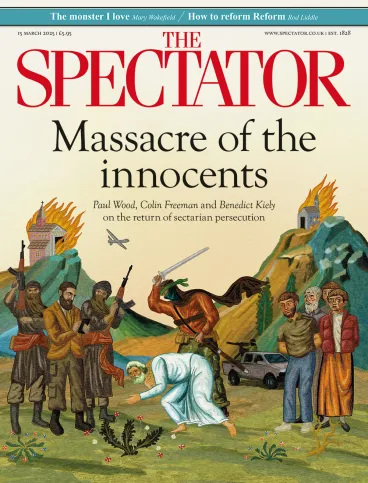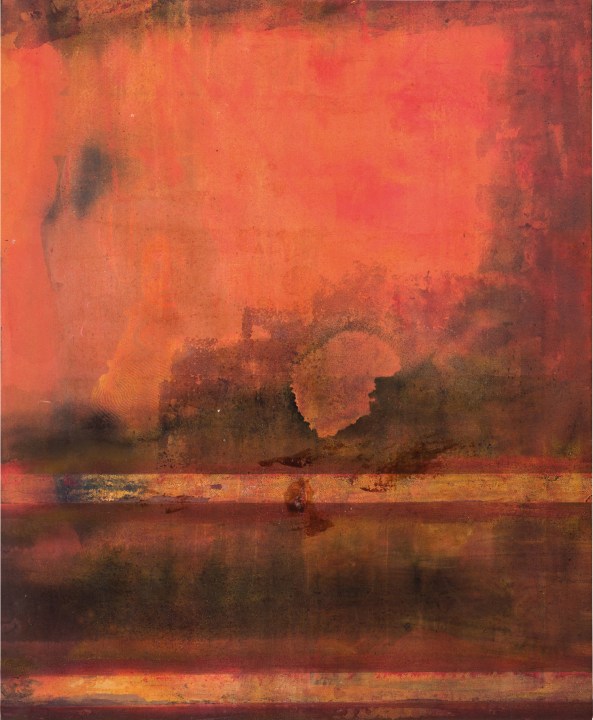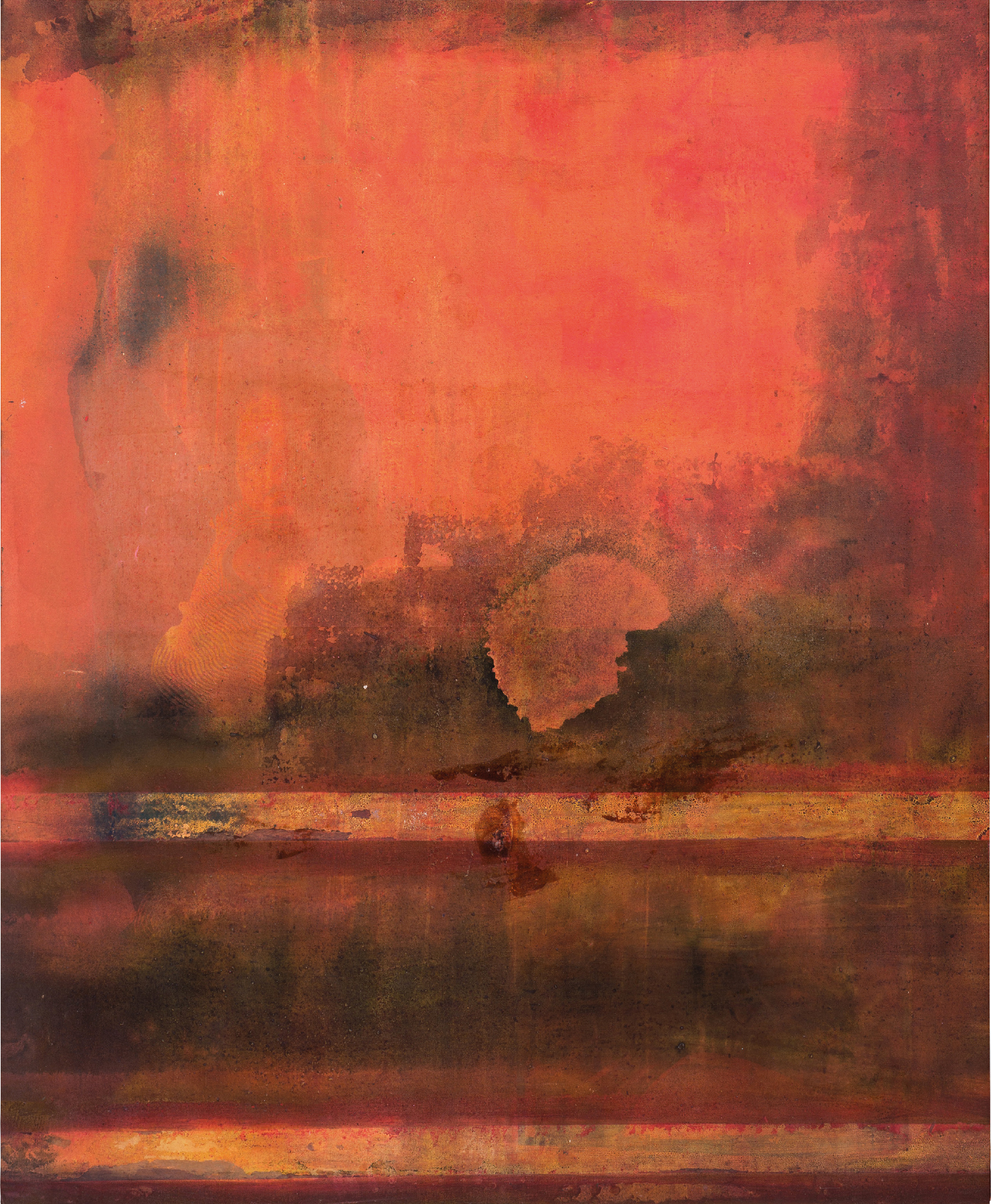
‘I’m full of excitement waiting for this to dry out,’ Sir Frank Bowling exclaims. We are sitting in his studio, a room in a quiet Victorian yard that survives amid the tower blocks of Elephant and Castle. In front of us a semi-finished canvas – a glorious welter of yellow and orange in diverse modulations – is pinned to the wall.
It’s executed in acrylics, a water-based material. Bowling, like Turner – one of his heroes – believes in using buckets of water, sometimes more or less literally. ‘I don’t always use conventional tools to mark the surface,’ he confides. ‘Sometimes marks are made by a brush, sometimes by simply flinging the paint at the canvas.’ Such matters have long fascinated Bowling. ‘The possibilities of paint are never-ending,’ he once announced. And he has been exploring novel ways of putting it on canvas since Winston Churchill was prime minister: new combinations of colour, surface, texture, density, fluidity, thickness and thinness. Having weathered a period of relative neglect, Bowling is now widely regarded as one of the most inventive painters alive.
Two days after we spoke, Bowling celebrated his 91st birthday. He began life in the town of Bartica in what was then British Guiana, now Guyana. Since that moment, getting on for a century ago, he has travelled on a long transatlantic odyssey. He first crossed the ocean to London in coronation year, 1953. Then from the mid-1960s to the late 1970s Bowling shifted to New York. These days he sticks to London.
At night in bed he stares at the cracks in the ceiling, thinking about new pictures and how they might evolve. According to his son Ben, who now runs his studio, he would be at work seven days a week if the staff didn’t need an occasional break.
I’ve been visiting this studio and chatting with him for 35 years; his work and his thoughts have become part of my life. Some time ago Bowling confided in me that he thought he must be an ambitious artist: ‘I can’t think what I can be but ambitious to have stuck it for so long.’ What is that ambition? ‘Whatever drives one as an artist – to make it more new.’
In those days his then assistant, Spencer Richards, held him up physically so he could work. Now he is wheelchair-bound and his grandson, Frederik, helps him. In his nineties he is if anything more productive than ever. In the studio a couple of recently completed paintings are leaning against the wall and another lies on the floor awaiting framing. Elsewhere, Ben showed me a huge and resplendent work suggestive of a vertical slice of landscape, from swampy pond to golden sunset.
Bowling is widely regarded as one of the most inventive painters alive
This is intended as his contribution to this year’s Royal Academy exhibition. The unfinished picture we are waiting to dry is destined, Bowling hopes, for a show opening at Hauser & Wirth in Paris next week. In the meantime, a recently rediscovered picture is on show at the Holburne Museum, Bath. This features in an exhibition of portraits, alongside those of Bowling’s fellow student David Hockney and erstwhile mentor Francis Bacon. By luck and talent, he was part of more than one of the most exciting moments in late 20th-century art. At the Royal College of Art, he was in the same talent-filled year as Hockney, Allen Jones and R.B. Kitaj, while Bacon took him under his wing (until they fell out).
Bowling’s early work was – like that of his peers – figurative, but for more than half a century it has been – for want of a better word – abstract. One picture, ‘Dan With Map’ (1967), has hidden within its sumptuous veils of orangey red an image of Bowling’s son Richard Sheridan Bowling, otherwise known as Dan, so faint you can detect it only if you know it’s there.
At the time when this was painted, Bowling was embarking on his first, heady New York period. He moved to the city in 1966 and found himself in the midst of an even larger maelstrom of talent. For years Bowling lived in the Hotel Chelsea, the haunt of many artists, writers and musicians, running a very long tab as was the custom at the time. He did the same at Max’s Kansas City, the restaurant frequented by an encyclopaedic array of artistic notables from John Lennon to Andy Warhol.
Among his friends was the painter Clyfford Still, whom he was surprised to discover was an avid enthusiast for English painters such as Turner, Constable and the Norwich school, and their brushwork in particular. Still was so preoccupied with his art he didn’t want to discuss anything else. ‘If you weren’t going to talk about painting, the nitty-gritty, working the paint up on the surface, he just ignored anything that was being said. I admired that.’
Bowling himself is not one for what he calls ‘the chatter’, preferring to turn his thoughts to matters he considers deeper, especially fresh ways of making a painting. Artists working in New York in those years, as he puts it, ‘used their physical selves as a reference’. Where Jackson Pollock had danced around his canvas, flinging skeins of paint, in the 1970s Bowling devised a tilting platform which allowed him to control the flow of paint precisely as it cascaded down. In this way he created a series of poured paintings now rightly considered masterpieces.
Another New York acquaintance was the painter Barnett Newman. Bowling confesses he always ‘had a thing about’ this great abstract artist. Indeed his own work is sometimes visibly in dialogue with Newman’s.
By luck and talent, he was part of more than one of the most exciting moments in late 20th-century art
The great man perhaps also had a sartorial influence. Newman advised young artists not to give the philistines a chance to dismiss them as shabby bohemians. ‘The way he dressed!’ Bowling recalls. ‘Always with a suit and a monocle; I never saw the monocle in his eye, it was always in his top pocket.’ Bowling himself is always marvellously turned out in a chromatic symphony of colours.
The spectral face in ‘Dan with Map’ is a clue to the nature of Bowling’s abstraction. Namely, that his work is full of signs and tokens of reality. For example, adhering to the surface of that unfinished yellow painting is an assortment of disparate items including pieces of vegetation (one might have been a daffodil). In addition, there is a scrap of filigree crochet work and a thick black line formed, he thinks, by a strip of masking tape.
These are typical, if only in their heterogeneity, of the bits and bobs that have found their way into Bowling’s work. His wife Rachel Scott, a distinguished textile artist in the manner of Anni Albers, told me how her car keys had found their way on to a certain canvas in the 1980s. The curator and writer Sam Cornish listed among the flotsam that has lodged in these rivers of paint, bank notes, cut-up bank cards, plastic animals, ‘shirt collars, silk handkerchiefs, oyster shells, party poppers and a crocheted ostrich’. Bowling himself confessed that on his way to the studio he used to gather flowers and ‘bits of wood and things and just chuck them on the surface’. At the time, he went on, ‘I was looking at Matisse and taking in what he was doing with collage.’
Collage is the theme of the forthcoming show in Paris. This extends to Bowling’s use of marouflage, a technique in which pieces of painted canvas are glued and – in his case more often – sewn together. In this way he makes a species of collage by cutting up and reassembling his own paintings.
Throughout his life Bowling has lived close to rivers. And this has entered his work too, not always as literally as those wildflowers and other unconsidered trifles. His native Guyana is situated in the delta region of one of the great river systems of South America. In the 1980s, back in London by the Thames, he remarked on the thrill of working in ‘Turner’s town’. Then for a while he split the year between Southwark and another studio in the shadow of the Manhattan Bridge on the East River.
His work, he once said to me, is ‘always something to do with water because this is the nature of the material’. He even thinks of his paintings as his own reflection in ‘an area of water, a pool, say, or a river’. But it’s a mirror not of his face but of his sensibility, moods, thoughts and reactions to chance circumstances. So as we wait for this painting to dry, he ponders what will happen to it next.
Iconic: Portraiture from Francis Bacon to Andy Warhol is at the Holburne Museum until 5 May. Frank Bowling: Collage is at Hauser & Wirth Paris from 22 March until 25 May.








Comments